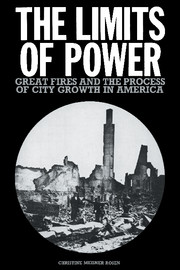Book contents
7 - The rebuilding of Boston
Published online by Cambridge University Press: 22 September 2009
Summary
On the evening of Saturday, November 9, 1872, a fire broke out at the corner of Summer and Kingston Streets in Boston. It was first noticed as a reddish glow in the basement windows of the building shortly after 7:00 p.m. and was soon seen “roaring up the elevator” to the upper stories. By 7:20 the flames had attracted a crowd of onlookers, but the first alarm was, inexplicably, not sounded until 7:24. By the time fire companies finally began to arrive, the building was “one vast furnace,” the heat so intense that no one could get within fifty feet of it and so powerful that the building's granite walls began to explode, sending stony fragments flying in every direction in pieces up to thirty pounds in weight.
From the start, the Fire Department found itself no match for the heat and the flames. The delay in sounding the first alarm was only one of its problems. For a variety of reasons, the Department had no fire houses in the central district where the fire broke out. Ordinarily, it had gotten around this difficulty by dispatching several fire steamers to a blaze whenever a first alarm in the business area came in. On November 9, however, most of the horses in Boston were suffering from a plaguelike disease called epizootic. Half the Department's horses were too sick to stand without support, and almost all the rest were too weak to be put into service.
- Type
- Chapter
- Information
- The Limits of PowerGreat Fires and the Process of City Growth in America, pp. 177 - 248Publisher: Cambridge University PressPrint publication year: 1986



